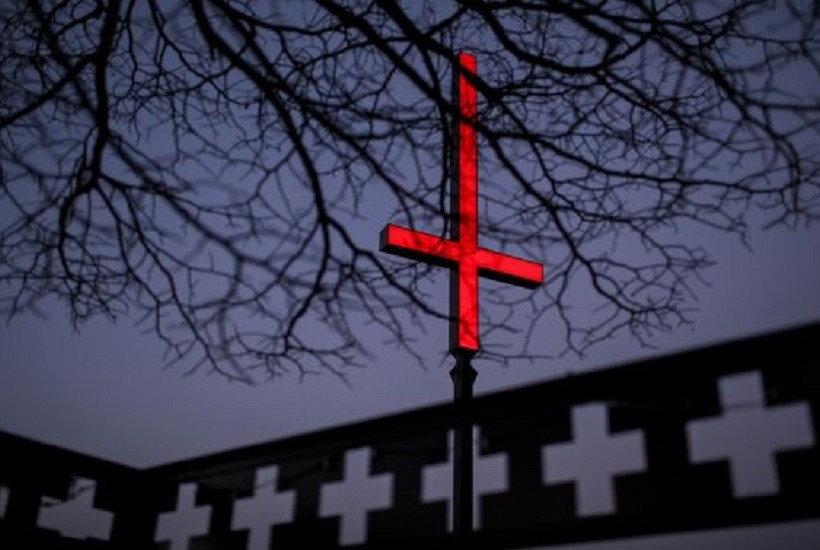The proper way to understand the giant inverted crosses as part of Tasmania’s Dark Mofo festival is not an expression of macabre and strange art. Rather, it is a powerful symbol of the progressive left’s visceral hatred of Christians.
The giant red crosses erected as part of Tasmania’s Dark Mofo festival has caused offence to various Christian groups who recognize the inverted cross as a Satanic symbol of all things opposed to their faith (Yes, it can also represent St. Peter who was crucified upside down, however, given the deliberately macabre and neo-pagan ambience of Dark Mofo, veneration of St. Peter is hardly what the curators have in mind).
Richard Condie, Anglican bishop of Tasmania, went so far as to call it “state-sanctioned blasphemy” and Anaba Suriel, Coptic Bishop of Melbourne, labelled the display “an anti-Christian symbol in mockery of Jesus Christ” and a particularly painful reminder to Coptic Australians of the persecution they experienced in Egypt for being “people of the cross.”
Make no mistake about it. An upside down cross is as offensive to Christians as cartoons of the prophet Muhammed are to Muslims and smashed Stars of David are to Jews. The curators of the art knew perfectly well the uproar and offence that this art was going to cause. The offence caused was not careless, it was meticulously calculated, and the festival’s director remains recalcitrant in the face of criticism.
As you can imagine, Christian refugees from Iraq, Syria, Nigeria, and North Africa are particularly affronted by the art because it rehearses some of the anti-Christian rhetoric that has been used to inspire violence against them. Don’t forget that ISIS’s magazine Dabiq had a whole issue dedicated to “breaking the cross” which justified the killing of Christians. I cannot help but think that the Dark Mofo directors and ISIS might have a few things in common when it comes to their shared animus towards Christians.
Of course, mocking of the cross has a long history.
Crucifixion was the punishment of slaves, bandits, and enemies of the state. So it was particularly offensive to Romans that the Christians honoured as a god a person whom Roman authorities had executed as a common criminal. The cross was considered impious as it was seditious: A crucified Jew rather than Caesar was hailed as Lord of the world.
Marcus Cornelius Fronto, an orator and rhetorician, condemned Christians on the grounds that “the religion of the Christians is insane, in that they worship a crucified man, and even the instrument of his punishment itself” (Minucius Felix, Octavius 9.)
Similarly, the philosopher Porphyry wrote about the story of a man who went to the temple of Apollo to ask the god what he might do to dissuade his wife from being a Christian. In Porphyry’s account, Apollo answered the man as follows: “Let her continue as she pleases, persisting in her vain delusions, and lamenting in song a god who died in delusions, who was condemned by judges whose verdict was just, and executed in the prime of life by the worst of deaths, a death bound with iron” (Augustine, The City of God 19.23).
The earliest piece of anti-Christian graffiti is the famous Alexamenos inscription, dated to around AD 200, found on Palatine Hill in Rome, on what probably was a school to train imperial slaves. The inscription presents a man with a donkey’s head hanging on a cross, while another man faces towards the cross in a pose of worship. The words “Alexamenos worships his god” are etched underneath. The allegation is clear: Christians worship a crucified ass!
Yet despite the shame and derision associated with crucifixion, the first Christians made the cross central to their worship, stories, symbols, and ethics.
The cross is a central symbol for Jesus Christ, his Church, and God’s love for the world. According to St. John, Jesus’s death is a revelation of divine glory (John 12:23; 13:31–32) and motivated by divine love (John 3:16; 15:13). The apostle Paul preached a message of “Christ crucified” because it is the very “power of God” (1 Cor 1:17–18, 23). Paul even regarded his own identity as indelibly and somewhat mysteriously connected to the death of Jesus to the point that he could say that “I have been crucified with Christ” and “the world has been crucified to me” (Gal 2:20; 6:14).
The author of Hebrews offers a stirring exhortation to his readers to remember Jesus, who “for the joy set before him he endured the cross, scorning its shame” (Heb 12:2). John of Patmos describes Jesus as the “Lamb who was slain from the creation of the world,” locating Jesus’ death as part of God’s pre-promised plan to rescue his people from the mire of an evil world (Rev 13:8).
Tertullian referred to the late second-century practice of making the sign of the cross: “At every forward step and movement, at every going in and out, when we put on our clothes and shoes, when we bathe, when we sit at the table, when we light the lamps, when on the couch, on a seat, and in all the ordinary actions of life, we trace the sign of the cross on our foreheads” (Tertullian, The Crown 3.). In the fifth century, Romanos the Melodist (ca. AD 490–556) wrote his famous hymn “The Victory of the Cross” which says: “In your opinion the cross is an instrument of folly, but all creation sees it as the throne of glory. On it Jesus is nailed, like a king waiting to be hailed.”
While Dark Mofo’s inverted crosses sadden me, I am not outraged by them, and I definitely do not want them taken down. I regard the crosses as exemplary tools with which to teach the Christian community some important lessons.
First, I will make sure my Christian students, my fellow parishioners, and my friends see the Dark Mofo’s inverted crosses for what they are. Their inverted crosses are symbols of the progressive left’s and the cultural elite’s pathological hatred of Christians. The left claims to embody the virtues of tolerance, diversity, and inclusion, yet deeply offensive symbols like these are (literally) iconic for the hatred and loathing they have for Christians. What is on display is their hunger to humiliate us and their insatiable appetite to cause offence for the sheer joy it gives them.
I will make sure Christian refugees from Syria, Sudan, and Iraq see these inverted crosses too. And I will explain what they mean: “See how much they hate you. See their joy at your humiliation. See their delight at the publicity they get when you complain. See their detestation of who you are and who you worship. Remember it and don’t forget it.”
Second, then comes the next lesson. “Even though they hate you and mock the holy cross, do not hate them back. They make the cross an object of hate and ridicule, because hatred gives them focus and purpose, while ridicule gives them a sense of superiority and power over you. But to you, dear brothers and sisters, let the cross be the reminder of power-in-powerlessness, how love triumphs over hate, mercy for the undeserved, and kindness without limits.”
I want to thank the Dark Mofo artistic team for their inverted crosses. They are genuinely illuminating and sobering. Christians are reminded how much they are resented by certain quarters of the progressive left and it is an important reminder that we must not try to out-hate our enemies, rather, we must out-love them. The cross is glorious and the Dark Mofo leadership is powerless to change that. Let them enjoy their hatred and mockery, but do not imitate them, and do not let them change you. That is your victory, the victory of the crucified within you.
Rev Dr Michael F. Bird is an Anglican Priest and theologian and a lecturer at Ridley College in Melbourne, Australia. He tweets @mbird12 and blogs at Euangelion.
Illustration: MONA
Got something to add? Join the discussion and comment below.
Got something to add? Join the discussion and comment below.
Get 10 issues for just $10
Subscribe to The Spectator Australia today for the next 10 magazine issues, plus full online access, for just $10.


























Comments
Don't miss out
Join the conversation with other Spectator Australia readers. Subscribe to leave a comment.
SUBSCRIBEAlready a subscriber? Log in